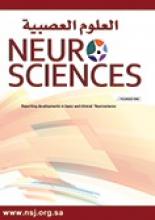Abstract
OBJECTIVE: Severe head injury is the leading cause of death in the younger age group and it is an epidemic health problem in Saudi Arabia. Several factors contribute to this observation. These include socio-economic prosperity, poor driving behavior and attitudes. The study was conducted to determine the magnitude of severe head injury in the Eastern Province of the Kingdom of Saudi Arabia (KSA) and to emphasize the importance of application of intracranial pressure (ICP) monitoring in severe head injury.
METHODS: A retrospective study of 178 patients admitted to King Fahad Hospital of the University, Al-Khobar, KSA during the period from 1992-2002 with severe head injury Glasgow coma score (GCS) <\=8 included the analysis and correlation of clinical and radiological factors such as age, sex, nationality, cause of the trauma, epilepsy, alcohol intake, extracranial injuries, x-ray findings, CT scan findings, surgical intervention, and application of the ICP monitor to the outcome. The data were subjected to detailed analysis using the Statistical Package for Social Sciences version 10.
RESULTS: The study group was divided into 2; the first group consisted of patients treated without the application of the ICP monitor and consisted of 126 patients, and the outcome was satisfactory (good recovery or moderate disability) in 38% and 62% had poor outcome (severe disability or death). The second group was 52 patients where ICP monitor was used. Two thirds of them showed high ICP. The outcome in this group was satisfactory in 77% and poor in 23%.
CONCLUSION: Severe head injury is a major health hazard leading to a high rate of morbidity, disability and death. The benefit of an ICP monitor should be clearly illustrated to all neurosurgical centers in KSA in order to consider routine and early applications of ICP monitoring as one of the basic measures in severely head injured patients.
- Copyright: © Neurosciences
Neurosciences is an Open Access journal and articles published are distributed under the terms of the Creative Commons Attribution-NonCommercial License (CC BY-NC). Readers may copy, distribute, and display the work for non-commercial purposes with the proper citation of the original work.






